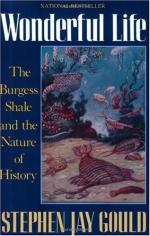
|
| Name: _________________________ | Period: ___________________ |
This test consists of 15 multiple choice questions and 5 short answer questions.
Multiple Choice Questions
1. What did the dissenter believe should happen to Aysehaia?
(a) It should jump two classes.
(b) It should spread to the lower classes.
(c) It should be retained in a known class.
(d) It should not exist.
2. What new view did Whittington now understand?
(a) Few Burgess fossils cannot be placed in any known taxonomy.
(b) Many Burgess fossils cannot be placed in any known taxonomy.
(c) No Burgess fossils fit within any known taxonomy.
(d) Many Burgess fossils fit within one known taxonomy.
3. How did Naraoia help the Burgess Drama?
(a) By helping complete it.
(b) By helping destroy it.
(c) By helping summon it.
(d) By helping save it.
4. How can scientists describe the structure of evolutionary inference?
(a) Quite complex.
(b) Fairly easy.
(c) Fairly intuitive.
(d) Quite simple.
5. What did Morris publish while still in graduate school?
(a) 7 articles.
(b) 6 monographs.
(c) 4 papers.
(d) 5 papers on new phyla.
6. Which old category did the team focus on to classify Opabinia?
(a) "Trilobites."
(b) "Mechanisms."
(c) "Beetles."
(d) "Worms."
7. What is the second subtitle for the Act 5 chapter?
(a) Wednesday (There Are No Final Answers).
(b) Doomsday (There Are No Final Statements).
(c) Doomsday (There Are Final Answers).
(d) Doomsday (There Are No Final Answers).
8. What did Gould note about the Burgess work at this time, in Act 5?
(a) Whittington has left the work to Simon and Briggs.
(b) Whittington and Simon have begun to work on other topics.
(c) Whittington, Briggs and Simon have begun to work on other topics.
(d) Briggs has left the Burgess team.
9. What kind of picture do scientists have of multi-cellular animal life because of the Burgess Shale?
(a) General.
(b) None.
(c) Distinct.
(d) Imagined.
10. What does Gould say represents the Burgess message?
(a) Yohoia.
(b) Naraoia.
(c) Opabinia.
(d) Scthyoria.
11. How many major contingencies along the path toward human development does Gould guide the reader through?
(a) Nine.
(b) Eight.
(c) Four.
(d) Seven.
12. How many acts does the Burgess Drama have?
(a) Five.
(b) Four.
(c) One.
(d) Seven.
13. What does the 'grab bag' provided by the Burgess Shale consist of?
(a) Appendages and anatomical forms.
(b) Corpuscles and carapaces.
(c) Cartilage and fossils.
(d) Appendages and tissues.
14. What do bats superficially resemble?
(a) Birds.
(b) Albatross.
(c) Mammals.
(d) Predators.
15. How was Whittington inclined to see Opabinia?
(a) As a lunatic.
(b) As crazy.
(c) As insane.
(d) As an oddball.
Short Answer Questions
1. What large crab with an enormous number of spines did Collins publish a monograph on in 1985?
2. What is the third stage of the fauna?
3. What is Canadaspis?
4. What is the problem with the Burgess Shale in relation to many of the similarities and distinctions?
5. What adjectives describe Whittington?
|
This section contains 470 words (approx. 2 pages at 300 words per page) |

|




